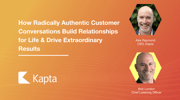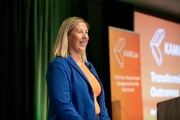KAMCon 2023: How to Thrive in a World Where Customer Expectations Have Changed
in Customer Success, Strategic Account Management, Customer Engagement, Key Account Management, Risk Management /CEO of Kapta, Alex Raymond, gave a presentation at KAMCon 2023 about what businesses need to do to thrive in a world where customer expectations have changed.
Alex started out by discussing what’s changed, why they’ve changed, and what the ramifications are:
“Your customer’s expectations have massively changed. If we don’t respond appropriately, we’re going to wind up on the wrong side of that big black line that someone’s CFO is putting through the budget.” And if we’re on the wrong side of the line, guess what? The account’s shrinking, they’re leaving, or they’re not calling us back.
So, what do I mean when I say that customer expectations have changed? We just went through a pandemic, then coming out of the pandemic, we had a recession. Then coming out of the recession, we had a bank collapse.
Now, our customers are just as concerned, nervous, and full of uncertainty as we are about what’s going on in the world."
So how should we respond to these changes?
According to Alex, “The things that helped us win in the past are not the things that are going to help us win in the future.”
We’ve got to change how we think. Customers no longer care about our specific offering or the length, strength, or quality of our relationship with them. What they care about is whether they are getting a result or outcome that is helping them meet their goals.
Consider these facts:
- Our customers are harder to engage and easier to lose than they’ve ever been.
- Less than a third of them think that we understand what their needs are.
- Less than half of our customers believe that we are delivering on the promises that we made to them during the sales process.
- 71% of our customers have a somewhat lukewarm attitude toward their vendors.
- 11% of your customers are actively trying to replace you
We know that these are issues and today we know that churn is a big problem. Everything is taking longer. The sales cycles are longer, customers are quicker to pull the plug, they’re quicker to downgrade us, and they are churning.
How do we start to combat this?
Alex pointed out that “The biggest issue is we assume that value is based on the relationships that we have.” But the customer is most concerned with when they are going to get any value from what they bought from you. That is what the customer is 100% interested in.
Our customers leave all the time. Our contacts get laid off or jump to a different job, and there are various organizational changes. So, we can’t rely on relationships anymore. We are now in a world where the outcome is what matters most to customers.
Our customers are under the microscope. Alex pointed out, “We’ve got to understand that if we don’t operate based on that, then we put ourselves at risk. So, outcomes are the thing we need to focus on.” They want to be able to tell their boss that they got your solution, and it is creating the desired outcomes so they can meet their goals. And those are the outcomes.
Sort Your Customers into the Value vs Relationship Matrix
Transforming customer outcomes takes us back to something that Jay Nathan shared in his presentation at KAMCon 2019. It is the concept of value versus relationship.
A customer who gets no value, regardless of how good the relationship will eventually downgrade, churn, or leave. Given this situation, there are no relationship things like dinners, lunches, or tickets to the ballgame that could save this account.
By contrast, a customer that’s seeing loads of value and is low on the relationship side will improve when relationship things are added to the partnership.
Sorting your accounts into this matrix enables us to see which of our customers are in a place where they get high value and we have a good relationship, where there’s a ton of potential growth. And the ones at the opposite end of the spectrum where there’s no value and no relationship. These are the ones we want to move away from.
The customers where there’s a high relationship and low value are in even greater danger. We need to create a plan to build value there.
But with the high-value, low-relationship account, building the relationship will only strengthen the account further.
As account managers and CSMs, we need to take a strategic approach to prioritizing how we spend our time, energy, and resources. This matrix is a useful tool for accomplishing that so you focus your efforts where you can have the greatest impact.
Deliver Greater Value
“We all get confused. We think the client's buying us, that they love us, and it's all about us, our company, or our product,” Alex explained, “No, it's about them and the utility or the benefit that they're getting.”
So, how do we deliver value? We identify the outcomes that the customer cares about. And we don’t take the first answer to our questions. We go deeper by asking better questions and we do more research. We deeply understand what’s going on within our customer accounts so that we can translate that into the desired customer outcome.
When we do that, we deliver the outcomes that will help with our retention rates, our growth rates, our internal employee retention rates, our profitability, and the valuations of our company.
That’s why account managers are huge drivers of profitability, revenue, and value for our companies.
Overcoming the Apathy Loop
We’re trying to snap the customer out of an apathy loop. The apathy loop is where everybody looks the same and talks the same, the websites are all similar, the QBRs are all alike, and they’re hearing the same lingo and acronyms. This makes it so customers can’t tell the difference between any of their current or potential vendors. When this happens, all customers do is ask vendors to cut price, cut price, and cut price. Then we are all stuck in this terrible loop.
To break out of the apathy loop, we must make some mindset shifts and change the way we think about things like QBRs, voice of customer interviews, and NPS surveys.
The method and roadmap that we recommend is called Know-Act-Measure. This is our KAM Process™. It’s all about:
How well do I know the customer? Do I truly understand who the people are, what they care about, and where they’re going as a business?
Based on that information, am I moving in the right direction? Am I taking appropriate action?
Am I doing the things that are going to help the customer get there?
And then finally, are we able to show and prove our value? Are we able to measure the results that the customer is getting?
Know-Act-Measure is the path, it is the roadmap for us to get there successfully.
Make the Mindset Shift
So, as Alex concluded, “We need to take the stuff that worked for us 12 or 18 months ago and change it. We must commit to learning more about our customers, being more customer-centric, doing voice of customer discoveries, and getting QBR hygiene down.”
That all helps us build the account plans and use the tools that we have, to be the most effective account managers that we can be. So, when we get to the point where we pass the current economic hiccup and uncertainty, organic growth, based on our deep knowledge of our customer’s needs and goals, propels our companies into the future.
Are you ready to overcome the apathy loop? Schedule a call with a team member to see how all the tools in Kapta can help.






